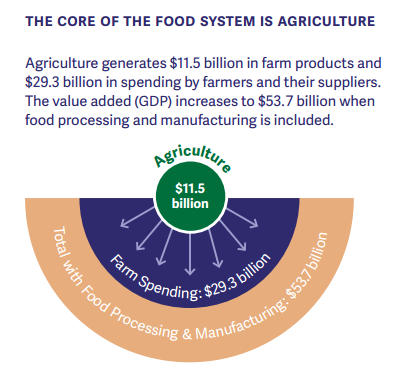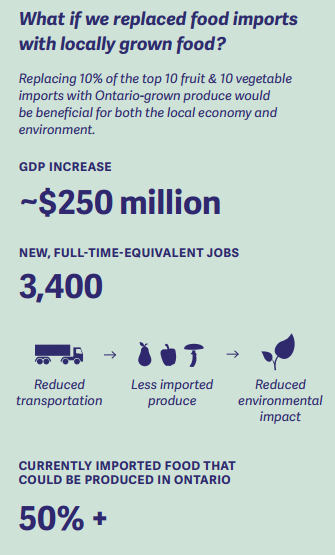The Dollars and Sense of a Healthy, Ecological, Equitable and Financially Viable Food System
Posted: February 25, 2015
Categories: Food in the News / GoodFoodBites / Policy News
Our agriculture and food system is oftentimes misunderstood by policy makers and the general public, and its potential undervalued. This is largely because most people are so far removed from their food and where it comes from. A recent report, Dollars and Sense: Opportunities to Strengthen Ontario’s Food System, helps to address misconceptions about the food system and explores opportunities for transformation in a way that will make policy makers sit up and take notice.
Dollars and Sense is a collaborative effort between the Friends of the Greenbelt Foundation, the George Cedric Metcalf Charitable Foundation and the J.W. McConnell Family Foundation. The report provides insights into the economic and environmental impacts of food production in southern Ontario, where roughly 98 per cent of the province’s food is produced, and studies the potential impacts of several shifts in food consumption and production (e.g. replacing 10 per cent of the top ten fruit and vegetable imports, converting 10 per cent of Ontario’s agricultural production to organic, and consumers adopting a healthier diet).
The report highlights the economic significance of the province’s agriculture and food sector, noting that, from farm to fork, it generates $63 billion in sales and $6.9 billion in tax revenue, as well as providing employment for 767,000 people – or just over one in every ten jobs in Ontario. However, what is valuable from a policy perspective is how it looks not only at provincial level data, but also provides economic data at a regional level, which will help ensure that food and farming are top of mind in local economic development efforts.
While economic considerations are important, policy makers are increasingly being asked to consider the environmental impacts of their policies as well. To this end, Dollars and Sense provides a detailed snapshot of the food system’s environmental impacts, considering factors like water and energy use, air emissions, waste generated and greenhouse gases produced. For example, the report notes that agriculture and food manufacturing alone accounted for over 565,000 terajoules of energy use in 2011 (compared to residential use of about 515,000 terajoules) and over 1.9 million tonnes of solid waste (compared to 1.7 million for all manufacturing). This suggests there are significant opportunities to reduce the food system’s environmental footprint, and that further investments could help farmers and food processors shift to more environmentally sustainable practices.
Finally, the report considers several different scenarios that demonstrate how changes in agricultural production and consumer behaviour can have major economic and environmental consequences. Probably the most interesting for Sustain Ontario’s members are: (1) replacing 10 per cent of the top ten fruit and vegetable imports with domestic products; and (2) shifting Ontario’s agricultural production to organic production methods.
In the import replacement scenario, the report estimates that replacing just 10 per cent of the top ten vegetable imports could translate into a $112.5 million increase in GDP, the addition of 1,590 jobs and $32.8 million in additional taxes for all levels of government. Similarly, replacing 10 per cent of top fruit imports could result in a $130 million increase in GDP, 1,837 new jobs and $37.8 million in additional tax revenues.
While feasible, it is essential to recognize that for this scenario to become a reality that concerted action would need to occur on many levels. Not only would farmers need to shift production away from crops like corn and soybeans, which currently occupy 70 per cent of total acreage in southern Ontario, but consumers would have to make a conscious effort to choose local products when shopping. And, investments would be needed into improved storage technologies and local processing capacity (e.g. drying, freezing) to extend the availability of local products beyond the traditional growing season.
In the organic scenario, the report considers the ability of Ontario’s food system to support a full transition to organic agriculture. According to the report, Ontario would still be able to meet its domestic needs for some agricultural products, such as grains, tomatoes, sweet corn and peppers, using organic methods without an increase in acreage. However, for most products, a switch to 100 per cent organic production would require more land, or an increase in imports, to meet domestic demand. This is because of the reductions in yields that would result from shifting from conventional to organic production — from 5 per cent for wheat to 25 per cent for fruit crops.
The report acknowledges that a full shift to organic production is unrealistic, but based on its calculations it does believe that a 10 per cent transition to organic production is feasible and could produce benefits for farm income and the environment (e.g. reduced pesticides/insecticides, increased biodiversity). Such a shift would still require significant supports for producers (e.g. research, extension services, funding for certification and transition) and policy and program changes to become a reality.
Dollars and Sense is an excellent resource for policy makers, or those who hope to influence government policy – we have used it already to support our recent pre-budget submission to the Ontario government. It provides insights into Ontario’s food and farming system, at both the provincial and regional level, and identifies further opportunities for policy and program development to support healthy, ecological, equitable and financially-viable food systems in the province.
Dollars and Sense is a summary of more detailed research conducted on the economic and environmental impacts of the food system in southern Ontario. You can download these reports from the Greenbelt Foundation or J.W. McConnell Family Foundation websites.
2 responses to “The Dollars and Sense of a Healthy, Ecological, Equitable and Financially Viable Food System”
Leave a Reply
You must be logged in to post a comment.



[…] Read Sustain Ontario’s summary: The Dollars and Sense of a Healthy, Ecological, Equitable and Financially Viable Food System. […]
[…] Read Sustain Ontario’s summary: The Dollars and Sense of a Healthy, Ecological, Equitable and Financially Viable Food System. […]